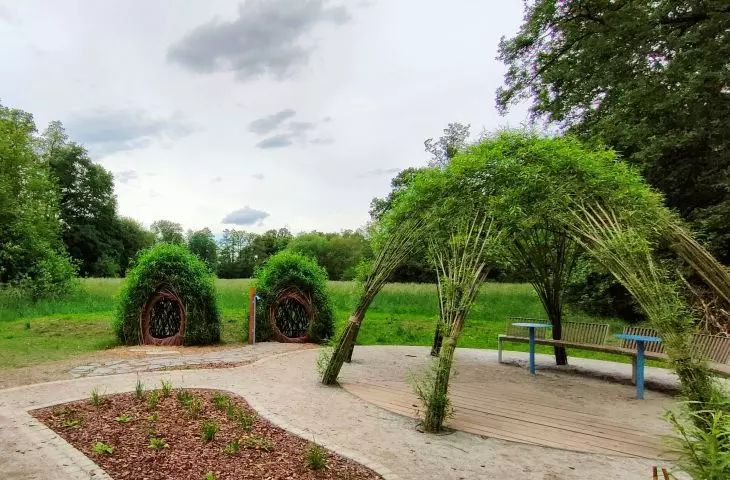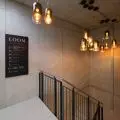Can a gazebo be alive? Wroclaw Landscape Architecture Studio IKROPKA designed a set of gazebos built from willows. "Living Gazebo" has become an element of Wroclaw's Eastern Park, attracting attention with its unusual solution and use of willows.
It was built of willow and allows you to hide from the sun or rain. The gazebo has become an unusual element of the landscape of the Eastern Park in which it was located.
"Living Gazebo"
© Pracownia Architektury Krajobrazu IKROPKA
Dominika Krop Andrzejczuk, a landscape architect who runs the IKROPKA landscape architecture design studio in Wroclaw, talks about the idea for the gazebo, the method of solution, the selection of plants and the care of willow in such a solution.
Wiktor Bochenek: How is the "living gazebo", which is an important element of your arrangement in Wroclaw's Eastern Park, created?
Dominika Krop Andrzejczuk (PAK IKROPKA): The living gazebo we designed in the Eastern Park in Wroclaw is indeed an essential element of the natural playground arrangement, created according to our design documentation.
The idea for this form of space arrangement came about for several reasons. The East Park area is a unique area - it has a wild, riverside character due to the fact that it is located between the arms of the Oława River.
It has flora and fauna typical of riverside areas. Due to the riverside nature of the park, it is the willow, of which the "living gazebo" is constructed, that is commonly found among the park's dendroflora. The willow arbor, therefore, is a perfect habitat fit with the site, as willow needs moisture in the ground to grow and survive.
The solution has been applied in the Eastern Park in Wroclaw
© Pracownia Architektury Krajobrazu IKROPKA
Wiktor: What are "living gazebos" built of?
Dominika: Living gazebos can be realized from many materials, but it is the honeysuckle willow (Salix viminalis L.) that gives the fastest, spectacular results. No construction is necessary under it, making the project extremely economical.
The project we realized took into account the proper braiding of willow vittles in a way that creates a safe structure for the gazebo itself. In the gazebo we placed seats and tables, so that in the playground we designed, parents and children have a chance to take a moment to relax in the shade, eat a meal in the fresh air.
There are also a great many other plants from which we can form gazebos - these include large trees - tree plantings known from the history of garden art planted in circles, were formed into green gazebos. Great for this are lindens, hornbeams or plane trees, as well as climbers.
With selected species of plants you can achieve a slightly different effect due to the capabilities of the plant. Hornbeams - most often formed into hedges, labyrinths will give a different effect, another will give lindens planted in the form of a circle, another will give plane trees, whose crowns can be shaped into umbrella-shaped canopies, and still other possibilities give on climbing plants.
Living arbors can be created without frames, forming them appropriately, or on frames - in the case of plants that need supports, these can be the previously mentioned various kinds of vines - here we have a whole range of variety from perennial to annual vines. With perennial, heavy vines with woody stems, stable and strong structures are required, withstanding significant loads.
The gazebo complements the other attractions located in this space
© IKROPKA Landscape Architecture Studio
Victor: How long does the process of overgrowing a "living gazebo" take?
Dominica: The overgrowth process of a living gazebo depends on the species we choose to make the "living gazebo" from. In the case of the willow gazebo we used in the project, the process of overgrowth of the natural structure is extremely fast, because willow vittles let go of their leaves already in the first growing season after planting. Our gazebo was realized in December, while it was already completely green in April. This effect lasts throughout the growing season until late autumn. The only condition is watering. Without this, the gazebo will wither. After the growing season - in late autumn and winter, the gazebo also looks beautiful, because the willow stems, while remaining bare, show the intricate way they were braided.
Victor: What is the care process like? How often do they require action?
Dominika: With a willow arbor, the care process is quite simple - it requires constant watering and pruning depending on the growth rate of the willow (which in turn depends on the soil and water conditions) - usually it is two to three times per season, but ultimately the amount needs to be adjusted as needed.
Victor: Is this a year-round solution, or is it more of a seasonal one?
Dominika: With a top gazebo, the effect of a green gazebo lasts throughout the growing season - from spring to late autumn. The only condition is watering. Without this, the gazebo will wither. After the growing season - in late autumn and winter, the gazebo also presents itself beautifully, as the willow stems, while remaining bare, show the intricate way they were braided.
© Pracownia Architektury Krajobrazu IKROPKA
Wiktor: Where is it a good idea to use "living gazebos" and where do they fail?
Dominika: "Living gazebos" will work anywhere, provided that the plants are properly selected for the habitat, light and water conditions, and that they are properly cared for. Top gazebos will work well all over Poland, wherever willows feel good, i.e. in wet areas - riverside areas, by streams. The willow willow (Salix viminalis L.) is a species that combines important features from the point of view of environmental characteristics, i.e. resistance to extreme climatic conditions, diseases, low soil requirements, high growth dynamics in successive growing seasons.
Victor: Inaddition to these, what can be found in the part you designed in the East Park?
Dominika: The natural playground project was designed to make Wrocław's East Park a place that combines a recreational function with an educational function, stimulating fascination with the natural world. Therefore, in addition to devices for physical play, we also designed interesting educational and sensory play elements.
The first of the zones is designed to provide a play area for children and adults. It consists of three parts, connected to each other by a gravel path, which allows access for a person in a wheelchair or access for a baby carriage. Interesting elements of small architecture allow for inclusive play - children and adults with different levels of fitness. The combination of colors, materials and textures used further stimulate imagination and creativity during play. The natural playground in the southern part is a place of ecological experience and a place for recreation.
Winding willows allow hiding from the sun
© Pracownia Architektury Krajobrazu IKROPKA
The sensory zone, which will include a xylophone, basalt slabs with engraved animal tracks and selected vegetation according to the design thought was to provide sensations affecting each of the senses.
The created second zone is an obstacle course stretched between the bridge and the path. Loosely laid concrete slabs are the accesses, and the shape of the squares where the equipment is placed is matched to the arrangement of the trees planted in and around the clearing.
Designed information and educational boards with author's illustrations refer to the history of the park, as well as contain information and interesting facts about the fauna and flora found in the development area.
Wiktor: Thank you for the interview.

































